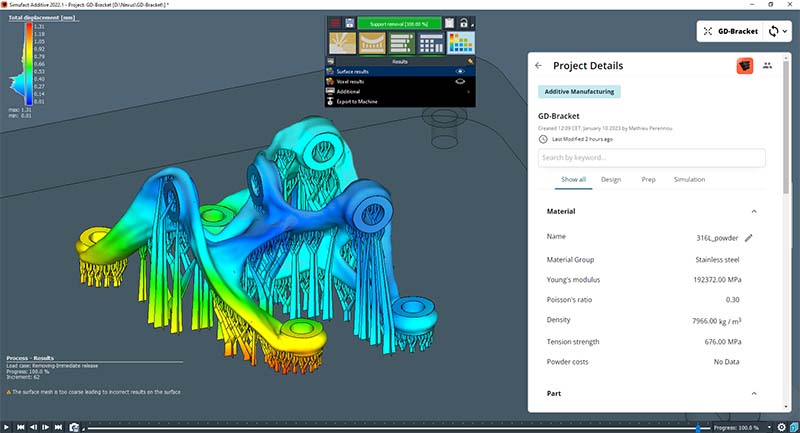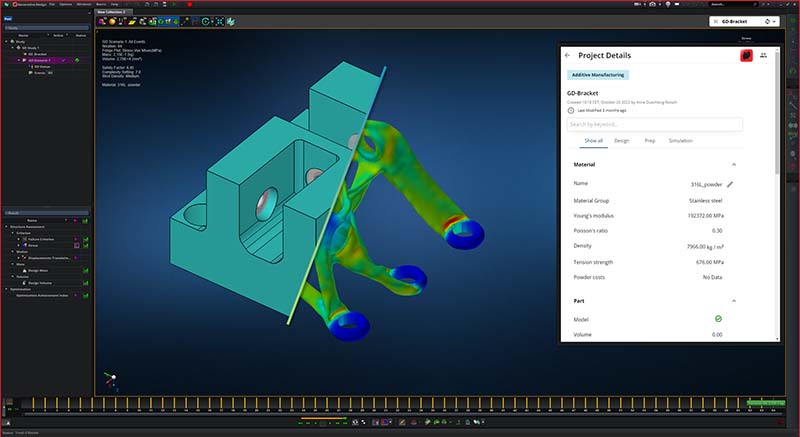Nexus, the new open cloud platform from Hexagon, has seen its open launch as is looking to put an end to silos for faster innovation by enabling realtime collaboration and feedback between its own and third party software.
Initially announced in June 2022, following beta testing by companies in Europe and North America the platform is now open to all and launches with a modest offering that its developers say is due to grow quickly with its users.
Co-engineered with Microsoft, Hexagon says that Nexus has been created to allow manufacturers to empower siloed teams so they can apply the data they need to invent sustainable and optimised products in a more efficient and agile way, and manufacture them to the required quality.
The platform will feature Cloud apps, both from Hexagon and third parties, as well as the ability to connect up on premises or legacy software – including from shop floor equipment.
“It’s a workflow that hopefully makes it much easier to solve problems because it drives this collaboration across disciplines,” said Stephen Graham, executive VP and GM for Nexus at Hexagon.
“We often hear it from customers, disciplines tend to be quite siloed. They’re individuals who’ve built up engineering expertise in their specific area over the last 20 years or more and they’re specialists in that area. But it’s almost like they speak a totally different language.” The example he gives is between the engineers trying to solve the manufacturability problems of something alongside its designers who have less awareness of practical issues in manufacturing, with Nexus targeting breaking down the barriers of communication and softwares to enable them to solve problems.
Nexus will also work across organisational boundaries, allowing for better collaboration between outsourced design and manufacturing services and bureaux, but enabling elements like AM build prep or post processing to be conducted in-house,
Highlighting Design for Additive Manufacturing as an element that can really benefit, Graham explains that the launch is just the start. “There’s a workflow that extends into a lot of other technologies that we offer… from our side, especially in metals 3D printing, people want to do CNC machining afterwards. And so that kind of embraces our CAM portfolio and then of course, the metrology portfolio as well.
“And so this is a workflow that we’re going to be extending over the coming months as well to embrace more of the technology that we have in the portfolio to extend the workflow.”
Key to all this is the technology that Hexagon has developed for linking apps and linking apps, and basically anything that generates data and the factory, for connecting that into Nexus.
“It allows each application or piece of technology to decide which data it’s willing to share with Nexus in the centre and also allows it to declare which kinds of data it’s capable of consuming from the centre. So the smart data contract is something that you set up, you only need to set it up once for each application or piece of hardware, or whatever it might be. Basically, anything that generates data can, in principle be connected into Nexus, you establish that connection once. And then once a piece of technology is connected, it’s then available, like a Lego brick to be connected together with anything else that’s been connected. So you can connect it once, and then it can participate in any number of solutions and workflows.
Graham explains that Hexagon can develop a smart data contract without any interaction with the supplier, but more generally that they want to work in partnership with hardware and software suppliers. “One of the big things about Nexus we’re going to emphasise the hell out of is that this an open platform, we want to work with any any third party vendors or technology – it’s not only about Hexagon.”
A key USP for Nexus is its real time data sharing between different applications – allowing engineers in different disciplines to work together simultaneously. To solve a problem each can look at the problem through the interface that they’re familiar with. So the metrology is looking through the metrology software, while the designer is looking through the 3D interface of the simulation software they’re familiar with, while the two of them work together to solve a manufacturability issue or similar.
Users can invite any external user to the platform to share information, for example sharing ‘live’ metrology trend reports up and down the supply chain with one click. Hexagon adds that as more apps and solutions are connected to Nexus, it should make it easier for companies to make improvements to how they work and to solve problems with colleagues in the same company or across the supply chain.
The first solutions on Nexus are commercially available from launch, and can be accessed and managed through the Nexus web interface, with a single login and user experience.
They include:
- Metrology Reporting, a Nexus App: The app connects Hexagon and third-party metrology data sources in Nexus’ secure cloud environment so that companies of all sizes can immediately report on previously untapped quality control data from their equipment to spot trends and identify tolerance issues. Any user can generate interactive three-dimensional CAD-based reports and insightful trend plots, KPIs and compliance documentation and up-to-the-minute data with colleagues, customers or suppliers.
- Materials Connect, a Nexus App: An all-new, cloud-based library for material data, that empowers manufacturers or material suppliers to manage material data, physical test data and behaviour models for use in product CAE workflows.
- Materials Enrich, a Nexus App: A first-of-its-kind Enrich app, it uses the Nexus platform’s machine learning capabilities and cloud-accelerated material behaviour simulations to help users find and simulate optimal materials that may have never been made or measured, improving the performance and sustainability of their products.
- Design for Additive Manufacturing (DfAM), a Nexus Solution: A pre-configured Solution that makes it easier and more efficient for teams to jointly develop an optimal metal 3D-printed part and prepare it for a successful print using the laser powder bed fusion process. Customers can use the Nexus web interface to connect Hexagon’s MSC Apex Generative Design and Simufact Additive process simulation software with AM Studio from CADS Additive and Materials Connect via the cloud, and easily manage user access to projects.
Parth Joshi, chief product and technology officer for Hexagon MI, said: “Companies across the world are pushing the boundaries of innovation, and Industry 4.0 is bringing ever more tools, technologies and data sources into view. However, the industry has a problem – processes and data sources are often siloed and team members struggle to collaborate across disciplines. This is severely hampering progress.
“If companies are to reap the benefit of smart manufacturing, we need to change the way we work. With Nexus, our aim is simple – to bring innovative minds together across disciplines and empower them. By leveraging Hexagon’s expertise in innovation, and by connecting people, technologies, and data we can help businesses bring ideas to life faster than ever before. We’re excited to see what customers will do with the technology from today.”









